Other Invertebrates
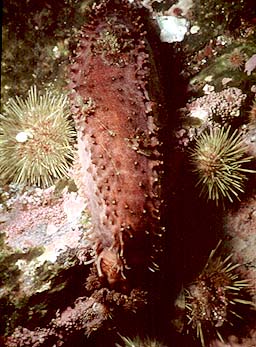
Orange-footed sea cucumber and green sea urchins.
“Other invertebrates” is the term we use to distinguish a whole host of spineless animals that do not drift with the tides like plankton. This, however, is a somewhat misleading definition. Many of the following species are quite familiar as attached creatures in their adult stages, yet most, marine invertebrates spend at least part of their life drifting on currents as zooplankton. Currents nourish the younger life stages and distribute these organisms to the far flung reaches of their adult range.
In the species descriptions below, people may recognize creatures from visits to tidepools or the dinner plate. As fish stocks in the North Atlantic dwindle, fishing communities are turning to invertebrates as a commercial crop. Some of them, like lobster and scallop, have become New England favorites while others, like squid and urchin, are sent to growing markets abroad. Still others are considered completely inedible, yet are used by people in other manners (see the horseshoe crab).
Species descriptions include:
Porifera: sponges
Cnidaria: anemones and soft corals
Mollusca: snails, bivalves and squid
Arthropoda: lobster and horseshoe crab
Echinodermata: sea stars, urchins and sand dollars
Chordata: sea squirts and tunicates
Species Descriptions: (by related groups)
Phylum: Porifera
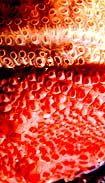
Detail of sponge colony
Boring sponge, Cliona celata, finger sponge, Haliclona oculata and crumb of bread sponge, Halichondria panicea, are a few sponges found on the Bank. Sponges are relatively primitive animals that live attached to the ocean floor or other hard substrates from the intertidal zone to great depths. On Stellwagen, they often encrust shellfish beds or the rare, large boulders left from glaciers.
Sponges are composed of many individual cells, each carrying out their job of eating, breathing and removing wastes. The body of the sponge is supported by a framework of numerous interlocking spicules (crystalline rods) or a tough fabric of protein spongin fibers. Sponges are filter feeders, straining out organisms from the water that constantly passes over their pore covered (ostia) bodies. Excess water and wastes pass out through the excurrent pores (oscula). Sponges can reproduce either sexually or asexually. Most all are hermaphroditic, producing both eggs and sperm. Sperm is released into the water and taken in by other sponges. Larvae then develop within the parent and are released along with the excurrent water. Sponges can also reproduce by budding off portions of the body.
Phylum: Cnidaria

Mouth and tentacles of frilled anemone
In the Gulf of Maine, you will find Northern red anemone (Urticina felina), red soft coral (Gersemia rubiformis) and Tubularian or pink-mouthed hydroid (Ectopleura crocea), to name a few. Cnidarians include jellyfish (see zooplankton), and hydroids. Their body is a hollow tube open at one end (the mouth). Tentacles covered with cnidocytes (stinging cells) surround the mouth. The paralyzing power of the stings and the retractile nature of the tentacles enable the cnidarians to bring to its mouth most small creatures which encounter it. Sea anemones are solitary, with most living attached to rocks, shells, or submerged objects, but a few burrow in sand or mud. Anemones can reproduce sexually, but they also reproduce by simple division (direct splitting into two individuals) and by budding off fragments of the foot, a process called pedal laceration.
Phylum: Mollusca
New England neptune, Neptunea decemcostata, the knobbed whelk, Busycon carica (9″ or 23 cm long) and the waved whelk, Buccinum spp. (4″ or 102 mm long). These are carnivorous snails which feed mainly on bivalves and dead fish. Whelks feed by steadying themselves with their broad foot and drilling their proboscis and radula (a rasp of small, horny teeth) into the victim. Female whelks lay eggs in long strings of parchment-like capsules which can be a yard or more in length. Whelks move about by waves of muscular movement which pass along the foot. They breathe by extracting oxygen from the water which is drawn in through the mantle into the gill chamber. Treasured by many beach combers, neptune shells are rarely found in good shape during beach walks. On the other hand, they can be found by the bunch in lobster pots as they scavenge for bait.
Moon snail, Euspira heros, (4 1/2″ (114 mm) long and 3 1/2″ (89 mm) wide) live in the tidal flats along the coast and on sandy or muddy bottoms from Labrador to North Carolina. They spend much of their time under the sand. They feed on clams, other moon-snails, and dead fish by enveloping the prey with their large foot and applying pressure with the proboscis and radula until a hole is made and the soft inner tissue is scraped and eaten. Eggs of moon snails are laid in a gelatinous sheet that wraps around the shell of the parent. These sheets of eggs are called sand collars or clergyman’s collars. In time, the egg case crumbles and larvae are released into the water.
Surf clam, Spisula solidissima, are the largest bivalve (two shelled) mollusks on Stellwagen at a maximum of about 9 inches wide (22 cm). Their shells tend to be heavy duty affairs, white, finely lined and covered with a dark outer membrane. A long muscular foot is used to pull the clam into the sand where it remains burrowed save for the tips of the siphons that bring water in and out of the body for oxygen, food and wastes. They are usually found in sandy habitats well mixed by strong currents and tides.
Few animals can feed on adult surf clams due to their tough armor and cryptic habits. Gulls may find a few adults during the lowest tides of the year in coastal areas and drop them from great heights to split the shells. They also form the basis for most of the famous chowders in New England.
 Deep sea scallop, Placopecten magellanicus, is a highly mobile bivalve. With swift claps of their valves, as though taking a bite out of the water, they propel themselves by the strong jets of water forced out through the hinge. They are found on sand and gravel bottoms from Maine to North Carolina. Deep sea scallops grow to 8″ (20 cm) in size. Scallops have 30-40 brilliant blue eyes that line the edge of their mantle. They feed and breathe by drawing water in between the shells, their organs taking in the oxygen or the minute food particles they need, and then passing out the water through the hinge. They propagate by shedding many small eggs into the water, which become fertilized by the sperm of other individuals. As young, they drift alongside innumerable other creatures with the tides; in turn, they help support numerous plankton feeders on the Bank. Predators of adults include sea stars, crabs, carnivorous snails, rays and people.
Deep sea scallop, Placopecten magellanicus, is a highly mobile bivalve. With swift claps of their valves, as though taking a bite out of the water, they propel themselves by the strong jets of water forced out through the hinge. They are found on sand and gravel bottoms from Maine to North Carolina. Deep sea scallops grow to 8″ (20 cm) in size. Scallops have 30-40 brilliant blue eyes that line the edge of their mantle. They feed and breathe by drawing water in between the shells, their organs taking in the oxygen or the minute food particles they need, and then passing out the water through the hinge. They propagate by shedding many small eggs into the water, which become fertilized by the sperm of other individuals. As young, they drift alongside innumerable other creatures with the tides; in turn, they help support numerous plankton feeders on the Bank. Predators of adults include sea stars, crabs, carnivorous snails, rays and people.
Long-finned squid, Doryteuthis pealeii, and short-finned squid, Illex illecebrosus. The fastest swimmers among the invertebrates, streamlined and sleek, squid fly backwards by drawing water in through their wide mantle opening and propelling it out through the funnel end. Side fins act as stabilizers. Ten arms or tentacles surround the squid’s head, two of those being longer than the rest. The longer tentacles are used for capturing food and mating purposes, with the shorter ones, lined with suckers, being used for handling captured fish. They breathe by means of gills in the mantle cavity, and have evolved a pair of eyes quite comparable to our own. Squids have ink sacs similar to octopi and expel ink into the water when alarmed. Predators include whales, porpoises, seals and larger species of fish. The Atlantic long-finned squid, grows to 17″ (43 cm) and is found from the Bay of Fundy to the West Indies; the Common short-finned squid, reaches 12″ (30 cm) and is found in open seas from Greenland to North Carolina.
Phylum: Arthropoda
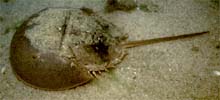
Horseshoe crab heading inshore for breeding
Horseshoe crabs, Limulus polyphemus, 24″ (61 cm) long and 12″ (30 cm) wide, live on mud or sand bottoms and range from the Gulf of Maine to the Gulf of Mexico. Their closest relatives are scorpions and spiders. These animals have remained virtually unchanged for more than two hundred million years. They have two large compound eyes and two smaller simple eyes on the dorsal side of the shell. Underneath are five sets of legs, with each leg ending in a claw-like structure which helps the animal to get a better grip as it pushes up and lurches forward. Horseshoe crabs breathe through a structure called book gills which are located on the underside of the abdomen. The long tail spine is used as a rudder and a lever to right the animal when it is turned over. Horseshoe crabs eat small bivalves and worms. Their mouth is located on the underside, between the legs. Growth is achieved by a series of molts, or shedding of the exoskeleton.
In spring, sexually mature animals (over 15 years old) congregate near shore from their winter feeding range, far out to sea. Males hang onto the backs of females with two, heavy, specialized legs as the female digs a hole and deposits the eggs. The eggs that escape the hords of migrating birds hatch out several weeks later and are washed down into the sea by the next full moon tide.
Horseshoes are superb hunters of shellfish (especially clams) and, until recently, a bounty was paid for their tails to reduce competition with shellfishers. Before that, masses of the animals were ground into chicken feed and fertilizer. Today, their blue blood is extracted from live animals for lysate to test human blood samples for bacterial toxins. These animals are returned to the wild and may be caught again for the growing conch bait industry. Almost nothing is known about their population status in the North Atlantic.

Lobster during threat display
Northern lobster, Homarus americanus, are solitary, aggressive animals that live in rocky ledges and crevices, both in bays and open ocean from Labrador to Virginia. Growing to 34″ (84 cm) in length, they have 2 pincers or claws, the larger being used for crushing or cracking hard objects like snails or bivalves, and the smaller sharper one being used to tear apart the prey or plant material on which it feeds. They have 4 pairs of legs for walking, and can “swim” by flapping their tails violently and propelling themselves backwards. They breathe with a set of stiff, closely branched gills located where the legs join the shell. In mating, the male impregnates the female who stores the sperm in her body for up to 9 months until she spawns. Her thousands of eggs flow over the sperm, are fertilized, and are attached to her swimmerets (small paddle-like appendages of the tail) where they stay throughout the 9-12 month incubation period. Lobsters molt from 14-17 times during the first year. This molting gradually decreases to once a year. Apart from humans, their chief predator is the cod.
Phylum: Echinodermata
Green sea urchin, Strongylocentrotus droebachiensis, and the Atlantic purple sea urchin, Arbacia punctulata. Sea urchins, in spite of superficial differences, are related to starfish and brittle stars. They are 2″ to 3″ wide (51 to 76 mm) and ¾” to 1-½” (19 to 38 mm) high, oval in shape, and have spines protruding from the top of the skeletal shell (or test) and five double rows of minute openings containing tube feet radiating from the center of the undersurface, where the mouth is located. Urchins are “broadcast” breeders, that is, they release huge quantities of egg and sperm to the tides where fertilization takes place. The larvae develop and drift in currents for many weeks before they metamorphose and settle on the sea floor. Sea urchins feed by using a structure, known as Aristotle’s Lantern, which consists of five teeth which come together like a bird’s beak and allow them to scrape algae off rocks. In addition, the spines can serve as a trap for gathering bits of seaweed which are passed around to the mouth.
Common sand dollar, Echinarachnius parma and keyhole sand dollar, Mellita quinquiesperforata. Sand dollars are flat versions of sea urchins, up to 3″ (76 mm) in diameter and disk-like. The surface of the skeletal plate (test) is covered with tiny movable spines which are used for burrowing into the sand. The 5-petal pattern on the upper surface are perforated to permit the protrusion of tube feet, which are used for respiration. As with the sea urchin, the mouth is located on the lower surface, and it contains a smaller version of the Aristotle’s Lantern apparatus. Sand dollars live on sandy bottoms, where they burrow for protection from waves and predators and to obtain food. They feed on fine particles of organic matter, and are, in turn, eaten by sea stars, flounder, haddock, cod and other bottom feeding fishes.
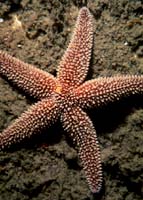
Northern sea star
There are several species of sea stars on Stellwagen Bank. They include: blood stars Henricia sanguinolenta (radius 4″ or 102 mm), northern sea star, Asterias rubens (radius 8″ or 20 cm), Forbes’ sea star, Asterias forbesi (radius 5″ or 130 mm) and slender sea star, Leptasterias tenera (radius 1½” or 38 mm). Among the most easily recognized of all marine invertebrates, sea stars are characterized by their flattened star shape and arms (rays) joined at a central disk. At the end of each arm is a small eyespot which is light sensitive. The sea star’s mouth and tube feet are on its undersurface. Locomotion is created by a water-vascular system; water enters through minute pores on the sieve plate on the upper surface, is drawn down radial canals lined with sucking tube feet, called ampulla. Sea stars will eat almost any animal they can catch and envelop. They commonly prey on worms, crustaceans and bivalves, especially oysters. After applying a steady pull on the prey with its tube feet, the sea star extrudes its stomach through its mouth, into the prey. Digestive juices pour into the soft parts of the victim, which is digested within its own shell. Sea stars can regenerate lost arms. When a ray is damaged, it is shed at a point close to the central disk in a process called autonomy. After autonomy, the cut surface heals over and regeneration of a new ray begins. In some species, if the ray which is torn off retains some part of the central body region, the missing rays and the rest of the body region will grow out and reconstitute a whole new sea star.
Sea Cucumbers, or Holothurians, are another class of Echinoderms including a number of species on the Bank, such as the orange-footed cucumber Cucumaria frondosa– see top photo- and the scarlet psolus Psolus fabricii. Their long, soft bodies may be anchored to rocks or burrowed in current swept dunes to cast for plankton. Eight to ten fringed arms radiate the mouth and anus. As rich currents sweep across these mucous coated appendages, trapped plankters are snagged. Each arm, in turn can be stuffed into the mouth and cleaned of food. For protection, some cucumbers can evert their stomachs, creating an unmanageable banquet for surprised predators.
Phylum: Chordata
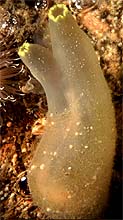
Sea vase showing siphons
Tunicates, also known as sea squirts or ascidians, belong to the phylum Chordata, which also includes fish, birds, mammals, reptiles and amphibians. For this reason, they are more closely related to us than any other invertebrate. Tunicates have two openings; the incurrent siphon and the excurrent siphon. They take in water through the incurrent siphon and filter out plankton and detritus. The water is then moved by cilia through the gill clefts, where oxygen is extracted, and finally exits through the excurrent siphon. Both male and female sex organs are found in a tunicate. However, they do not self-fertilize; sperm of one tunicate will fertilize the eggs of another tunicate in the water. As larvae, tunicates resemble tadpoles; after attaching to a hard substrate they undergo a metamorphosis and change into a blob-like creature encased in a leathery sac called the tunic. Some sea squirts common to the area are stalked tunicate, also known as sea potato Boltenia ovifera (body 3″ or 76 mm long, stalk 12″ or 30 cm long), sea peach Halocynthia pyriformis (5″ or 127 mm long), and northern white crust Didemnum albidu (1/8″ or 3 mm high and more than 4″ or 102 mm in width).
Orange sheath tunicate, Botryllus sp., have a very different growing form from the tunicates mentioned above. Larvae plant themselves to a hard substrate after being transported by currents as plankton. As the animal grows, it reproduces itself asexually through a process of budding
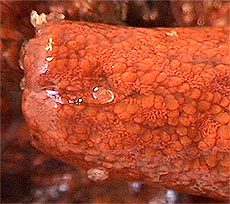
A colony of Botryllus spp. colonizing the old leaves of eel grass
– forming mats of genetically identical individuals, closely packed together. Each individual within the colony has its own ‘mouth’ or buccal siphon to draw water and food particles into the stomach. After digestion though, wastes are passed into a communal anus, or atrial siphon.
Colonies of these animals may form on rocks, kelp, pilings or boat bottoms. Each individual animal within the colony is encased within the leathery sheath or tunicate; the overall form of the colony usually adopts the shape of whatever it happens to grow upon. Colonies of this animal may wash ashore during winter storms and are often mistaken for sponges. Careful observers may note the star-like form of the different mouths surrounding the communal anus.

Our Work
Humpback Whale Research
Right Whale Research
Marine Animal Entanglement Response
Marine Geology Department
Water Quality Monitoring Program
Marine Fisheries Research
Seal Research
Shark Research
Marine Education
Interdisciplinary
Marine Debris and Plastics Program
Marine Policy Initiative
Cape Cod Climate Change Collaborative
Publications

